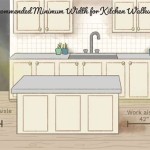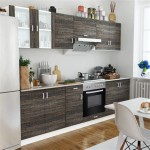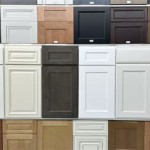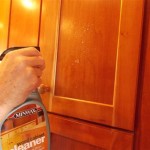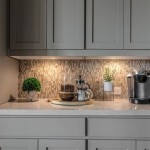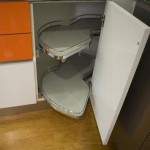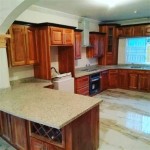What Material Is Used For Outdoor Kitchens?
The construction of an outdoor kitchen is a significant undertaking, demanding meticulous planning and careful consideration of the materials used. The selected materials directly impact the kitchen's longevity, aesthetic appeal, functionality, and resistance to the elements. Unlike indoor kitchens, outdoor kitchens are exposed to harsh weather conditions, including rain, sun, snow, and fluctuating temperatures. Therefore, opting for materials that can withstand these challenges is paramount. This article explores a range of materials commonly used in outdoor kitchen construction, highlighting their properties, advantages, and disadvantages to guide informed decision-making.
Stainless Steel: Durability and Modern Aesthetics
Stainless steel is a popular choice for outdoor kitchen components due to its exceptional durability and resistance to corrosion. Its non-porous surface inhibits the growth of bacteria and makes it easy to clean, a critical factor for food preparation areas. Stainless steel is commonly used for grills, refrigerators, sinks, and countertops in outdoor kitchens. The shiny, modern aesthetic of stainless steel complements a variety of architectural styles, and it can be easily integrated into different design schemes.
The grade of stainless steel is an important consideration. 304 stainless steel is a commonly used grade, offering good corrosion resistance for most outdoor environments. However, in coastal areas with high salt concentrations, 316 stainless steel, which contains molybdenum, provides superior protection against pitting and corrosion. Investing in higher-grade stainless steel can significantly extend the lifespan of outdoor kitchen components in harsh environments.
While stainless steel offers many advantages, it can be susceptible to scratches and dents. It also tends to heat up in direct sunlight, making surfaces uncomfortable to touch. Regularly cleaning and maintaining stainless steel can help minimize these issues. Furthermore, incorporating design elements like shade structures can mitigate the problem of excessive heat.
Concrete: Versatility and Robustness
Concrete is a versatile material used for various outdoor kitchen elements, including countertops, islands, and backsplashes. Its strength and durability make it able to withstand heavy use and exposure to the elements. Concrete can be customized with different colors, textures, and finishes, allowing for a wide range of design possibilities. Staining, stamping, and polishing techniques can create unique and visually appealing surfaces.
Precast concrete is a common method of constructing outdoor kitchen components. Precast pieces are manufactured off-site, ensuring consistent quality and dimensional accuracy. This approach streamlines the construction process and minimizes on-site labor. Alternatively, poured-in-place concrete allows for greater design flexibility but requires more time and expertise.
While concrete is a durable material, it is also porous and susceptible to staining. Sealing concrete surfaces is crucial to protect them from moisture absorption and staining from food spills and other contaminants. Regular resealing is necessary to maintain the integrity and appearance of the concrete. Concrete can also develop cracks over time due to temperature fluctuations and ground movement. Incorporating expansion joints during construction can help minimize cracking.
Stone: Natural Beauty and Timeless Appeal
Natural stone, such as granite, marble, and slate, offers a timeless aesthetic and exceptional durability for outdoor kitchens. Stone countertops and veneers provide a luxurious and elegant look. The natural variations in color and texture add character and visual interest to the outdoor space. Different types of stone possess varying properties, making it important to choose the right stone for the specific application and environment.
Granite is a particularly popular choice for outdoor kitchen countertops due to its hardness, heat resistance, and resistance to staining. It can withstand high temperatures without damage, making it ideal for use near grills and cooktops. Marble, while beautiful, is more porous and susceptible to staining than granite. It requires more frequent sealing and maintenance. Slate is a durable and water-resistant option for backsplashes and flooring but can be prone to chipping.
The cost of natural stone can be a significant factor. Installation requires specialized skills and equipment, adding to the overall expense. Stone is also a heavy material, requiring adequate structural support. Despite the cost, the durability and aesthetic appeal of natural stone make it a worthwhile investment for many homeowners.
Tile: Variety and Customization
Tile is a versatile material that can be used for various surfaces in outdoor kitchens, including countertops, backsplashes, and flooring. Tile comes in a wide range of colors, patterns, and sizes, allowing for extensive customization. Porcelain tile is a popular choice for outdoor applications due to its durability, water resistance, and resistance to fading. Ceramic tile is another option, but it is generally less durable than porcelain tile.
When selecting tile for outdoor use, it is important to choose a tile with a high PEI (Porcelain Enamel Institute) rating. The PEI rating indicates the tile's resistance to abrasion and wear. A higher PEI rating is recommended for high-traffic areas and surfaces that are frequently exposed to water and dirt. Grout is also an important consideration. Epoxy grout is more resistant to staining and mildew than cement-based grout.
While tile is a durable material, it can be susceptible to cracking in extreme temperatures. Proper installation is crucial to prevent cracking and ensure a long-lasting surface. Tile can also be slippery when wet, so it is important to choose a tile with a slip-resistant finish for flooring applications. The grout lines can also be difficult to clean, requiring regular maintenance to prevent staining and mildew growth.
Wood: Warmth and Natural Texture
Wood adds warmth and natural texture to outdoor kitchens. It can be used for cabinetry, framing, and decorative accents. However, wood is susceptible to moisture damage, insect infestation, and decay, making it essential to choose the right type of wood and protect it with appropriate finishes. Pressure-treated lumber is a common choice for framing and structural components due to its resistance to rot and insects. Hardwoods, such as teak, cedar, and redwood, are naturally resistant to decay and are often used for cabinetry and countertops.
Teak is a particularly popular choice for outdoor kitchens due to its high oil content, which makes it naturally water-resistant and resistant to insects. Cedar is another durable and aromatic wood that is well-suited for outdoor use. Redwood is known for its reddish-brown color and resistance to decay. Regardless of the wood species selected, it is important to apply a protective sealant or stain to prevent moisture damage and fading.
Regular maintenance is essential to prolong the lifespan of wood in outdoor kitchens. This includes cleaning, sanding, and re-staining or sealing the wood surfaces regularly. Wood is also susceptible to damage from UV rays, causing it to fade and crack. Incorporating shade structures can help protect wood surfaces from the sun. While wood requires more maintenance than other materials, its natural beauty and warmth make it a desirable choice for many outdoor kitchens.
Composite Materials: Low Maintenance and Durability
Composite materials, such as composite decking and composite cladding, offer a low-maintenance and durable alternative to natural wood. These materials are made from a combination of wood fibers and recycled plastic, providing the look of wood without the drawbacks of rot, insect infestation, and splintering. Composite materials are available in a variety of colors and textures, allowing for design flexibility.
Composite decking is often used for outdoor kitchen flooring and surrounding decks. It is resistant to fading, staining, and scratching, making it a durable and long-lasting option. Composite cladding can be used for cabinetry and siding, providing a weather-resistant and aesthetically pleasing surface. These materials typically require minimal maintenance, such as occasional cleaning with soap and water.
While composite materials offer many advantages, they can be more expensive than natural wood. They may also not have the same natural warmth and texture as real wood. However, the low-maintenance and durable properties of composite materials make them a popular choice for outdoor kitchens in areas with harsh climates or for homeowners who prefer a low-maintenance option.
Brick: Classic Charm and Thermal Mass
Brick brings a classic and charming aesthetic to outdoor kitchens. Its inherent durability and thermal mass make it a practical and visually appealing option for structures like pizza ovens, grill surrounds, and even complete kitchen islands. The ability of brick to retain heat is especially beneficial for cooking applications.
When selecting brick for outdoor use, it's important to choose a type that is rated for exterior applications, meaning it can withstand freeze-thaw cycles without significant damage. Different brick colors and textures allow for customization to match the desired aesthetic. Brick can be used in conjunction with other materials to create visually interesting and functionally sound outdoor kitchen designs.
While brick is durable, it is also porous and can absorb moisture, potentially leading to cracking in colder climates if not properly sealed. Mortar joints also require periodic inspection and maintenance to ensure structural integrity. The labor-intensive nature of bricklaying can contribute to higher construction costs compared to some other materials.
Considerations for Material Selection
The selection of materials for an outdoor kitchen involves a comprehensive assessment of various factors. The local climate is a primary consideration. In regions with harsh winters, materials that are resistant to freeze-thaw cycles are essential. Coastal areas require materials that can withstand salt air and humidity. The intended use of the outdoor kitchen should also influence material choices. For example, if the kitchen will be used for frequent grilling and cooking, heat-resistant and stain-resistant materials are crucial.
The budget is another significant factor. Some materials, such as natural stone, are more expensive than others, such as concrete or composite materials. Maintenance requirements should also be considered. Some materials, such as wood, require more frequent maintenance than others, such as stainless steel or composite materials. The overall design aesthetic should also guide material selection. The materials should complement the architectural style of the home and the surrounding landscape.
Finally, it is highly recommended to consult with experienced professionals, such as landscape designers or contractors, for guidance on material selection and construction techniques. Professionals can provide valuable insights and recommendations based on their expertise and knowledge of local building codes and regulations.

The Best Material For Outdoor Kitchen Cabinets Unique Design Blog

The Diffe Types Of Outdoor Kitchen Materials 4 Life Kitchens

The Best Material For Outdoor Kitchen Cabinets Unique Design Blog

6 Outdoor Kitchen Designs Types And The Best Countertop Materials To Use Granite Selection

Outdoor Kitchen Frame Wood Vs Metal Concrete Block Which Is Best

Kbbfocus Outside Chances What To Consider When Designing An Outdoor Kitchen

The Best Outdoor Countertop Materials Plus Design Ideas

Best Outdoor Kitchen Tile What Materials To Use Amazing Ideas

Building A Bbq Island Your Roadmap To Understanding Outdoor Kitchen Materials

The Best Materials For An Outdoor Kitchen Hi Tech Appliance
Related Posts

